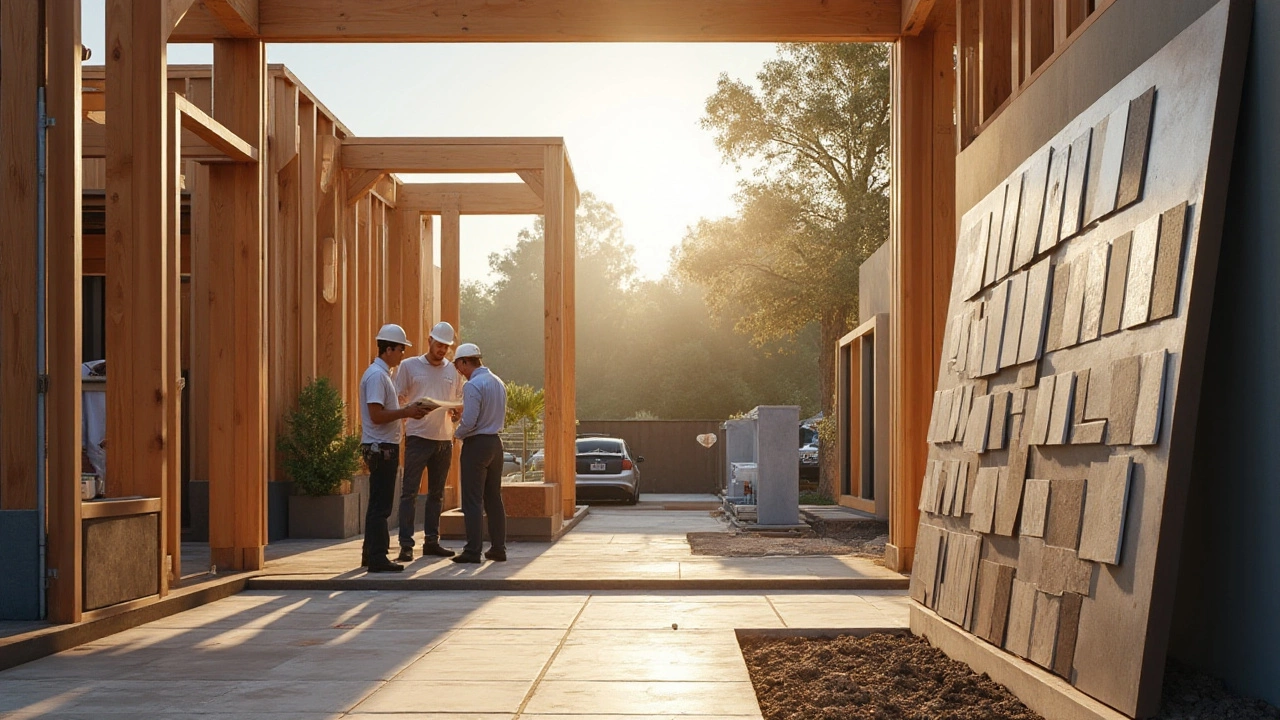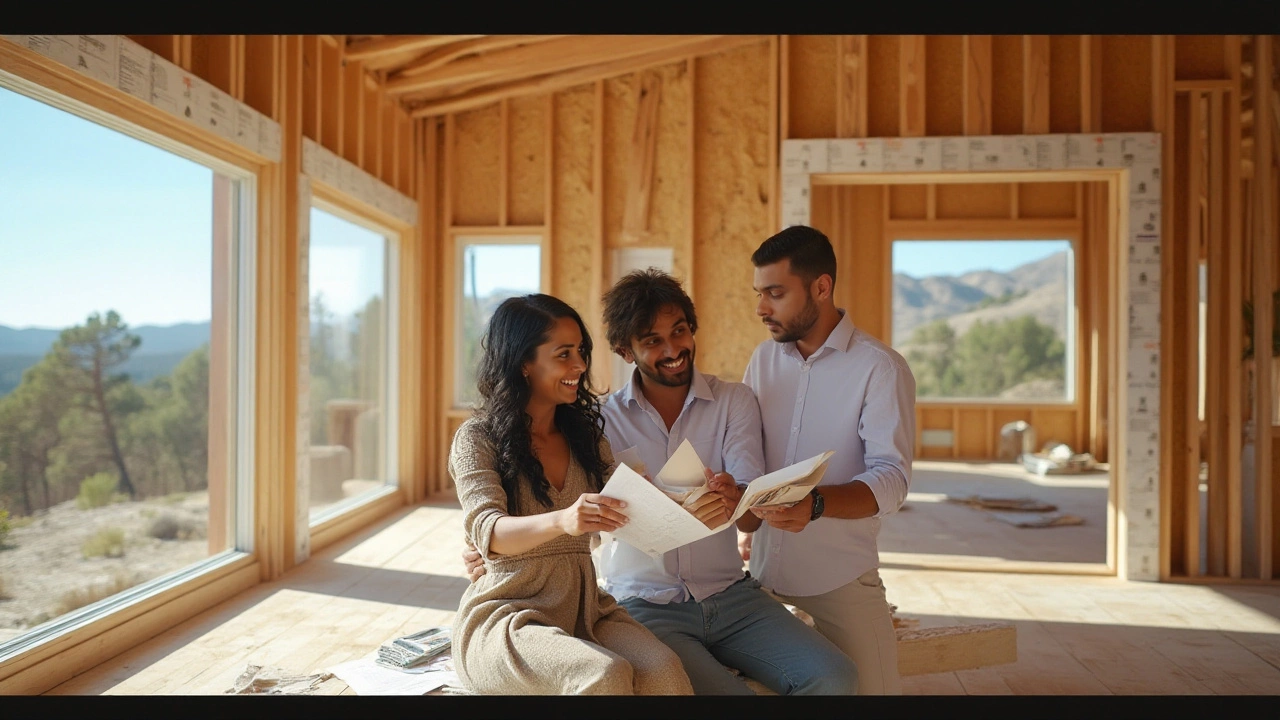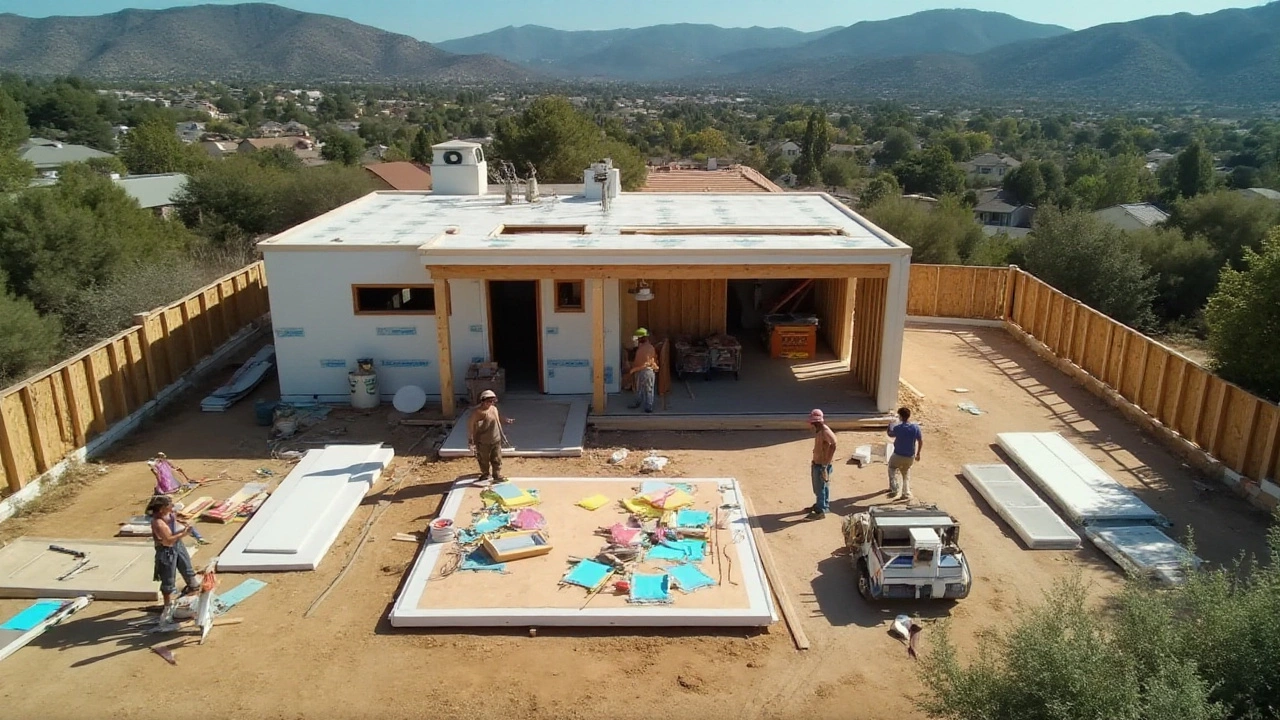Building a house in California, especially one that spans 3,000 square feet, is a venture filled with excitement and complexity. Each decision, from the soil beneath the foundation to the final coat of paint, comes with its costs. What really adds to the bill isn't just the bricks and beams but the state’s unique landscape and regulations.
The first thing to realize is that where you choose to build makes the biggest difference to your budget. Coastal views? Think premium prices. Inland? Maybe a little more manageable. Then there’s the choice of materials. High-end finishes can turn your dream home into a luxury statement—but they can also stretch your budget.
Labor costs in California are another piece of the puzzle, influenced by both demand and skilled worker availability. Don’t forget, navigating permits and legal requirements can also play a silent but significant role in your overall expenses.
Whether you're ready to break ground or still dreaming on paper, understanding these factors before the first shovel hits dirt will give you a solid start. Finish reading to uncover practical tips for building not just a house, but a financially sound future home.
- Location and Its Impact on Costs
- Material Choices and Pricing
- Labor and Design Considerations
- Building Permits and Legal Fees
- Tips for Cost-Effective Building
Location and Its Impact on Costs
When it comes to building a 3,000 sq ft house in California, location plays a pivotal role in determining the building costs. Known for its diverse climates and landscapes, California offers everything from coastal breezes to desert plains, and each region comes with its own price tag. For instance, constructing in cities like San Francisco or Los Angeles will see significantly higher price points. This is not just due to the costlier land but the demand for materials and skilled labor, both of which are notably high in urban hubs. The scenic beauty of these locations adds to the allure but also tacks on a premium cost, sometimes exceeding $500 per square foot.
Moving further inland, such as to areas like Sacramento or Riverside, the cost per square foot is often lower, sometimes dipping to as low as $200. These locations offer more affordable options without sacrificing the quintessential California lifestyle. In rural areas like the Central Valley, where land is more abundant and regulations less stringent, building costs might reduce further. But even here, one must consider transportation costs for materials and workforce, as these can unexpectedly bloat the budget.
Weather patterns also affect home construction costs. In coastal areas, the necessity for materials resistant to moisture and sea air increases costs. Inland, where temperatures can soar, energy-efficient designs might be more desirable, again influencing material selection and expenses. As Ken Rosen, chairman of the Fisher Center for Real Estate and Urban Economics at UC Berkeley, once pointed out, "Location dictates not just the price but the design and sustainability considerations that every builder must address."
A detailed understanding of local zoning laws, codes, and community aesthetics plays a role too. In some regions, stringent guidelines on style and sustainability can push costs higher as adaptations or special permits may be required. As such, anyone looking to build should research extensively or consult with local experts to avoid unforeseen expenses. It is also advisable to engage with community projects or attend city planning meetings to gain firsthand insight into upcoming infrastructure developments that could affect property values and construction timelines.
If you're considering a new build in California, be sure to prepare for both the visible and subtle influences of location on your building costs. Each region offers its distinct advantages, but understanding the financial implications is key to making an informed decision that aligns with both your budget and lifestyle.
Material Choices and Pricing
Choosing the right materials for your new home is a thrilling yet daunting part of the building process. It's not just about aesthetics; it's about durability, sustainability, and most crucially, cost. The variety of options can be overwhelming, from high-end timber to futuristic steel and eco-friendly bamboo. Each material not only influences the final design but also dictates significant chunks of your budget. The market dynamics mean prices can be like a rollercoaster, so understanding when and where to buy is a vital skill for builders and homeowners alike. Interestingly, in California, local sourcing can sometimes decrease costs while also supporting local economies.
The decision to incorporate luxury materials can add substantial value to your home. Think hardwood flooring that oozes elegance or counters made of gleaming granite. Yet, these choices also come with a hefty price tag and maintenance needs that should be carefully weighed. For example, while a soaring ceiling with exposed beams might inspire awe, the costs associated with such features can be daunting. Balancing between dream and budget often requires compromise, possibly opting for affordable alternatives that still provide the desired visual appeal. A simple decision like choosing between a solid wood door or a veneer one could impact both immediate costs and long-term maintenance expenses significantly.
"Price is what you pay, value is what you get," Warren Buffet famously said, highlighting the essence of material investment in home building. Not just a necessity, but a calculated decision that can enhance your home's worth.
The sustainability angle also drives choices today, often encouraged by California's strong environmental policies. Recycled or reclaimed materials can cut costs and contribute to a lower carbon footprint. Plus, using energy-efficient materials, such as high-performance windows or green roofs, can lower your utilities. Saving money over time and making your home a little kinder to Mother Earth is a winning combination many find hard to ignore. But, this doesn't mean every environmentally sound material is cheaper upfront; often, the reverse is true, with benefits realized only in the long run.
In terms of pricing, a rough estimation suggests wood or timber frames typically range from $25 to $50 per square foot, while steel frames might cost slightly more, between $35 and $70 per square foot. These figures can fluctuate based on factors like supply chain disruptions or labor shortages, which have been particularly volatile post-pandemic. Access to detailed pricing and availability can provide significant leverage when negotiating with suppliers or contractors. Being armed with detailed knowledge allows homeowners to push for the best deal possible, ensuring quality without shattering the budget.
For those wanting specifics, let’s look at some current figures. A solid steel beam needed for robust framing might cost $3,000 or more, while an equivalent in treated timber would be closer to $2,500. As the data shows, the upfront costs are notable, and it’s crucial to remember there’s no one-size-fits-all answer in home building, particularly across diverse climates and geographies found in California. With every square foot of that coveted 3,000 sq ft space, the materials you select today shape not just your home, but your future financial health.

Labor and Design Considerations
When setting off on the journey to build a 3,000 sq ft house in California, labor and design decisions are pivotal. The state is a melting pot of creative architecture and skilled craftsmanship, yet securing the right team can be both exciting and daunting. The abundant talent comes with its cost implications due to the high demand for experienced contractors, architects, and designers. This demand doesn't only reflect on salaries but can also affect the time it takes to hire and complete projects—often influenced by the season and economic climate.
Design decisions have a profound impact on labor costs. Intricate designs and custom features, while aesthetically pleasing, require more man-hours and specialized skills. Imagine opting for a sweeping, spiral staircase or a rooftop terrace with ocean views; both are dreams and budgeting minutes aplenty. Opting for significant customizations extends timeframes as workers need to meticulously craft each element to perfection, ensuring every wish and whim is realized. A smart approach balances vision with the insights of an experienced architect to align priorities without exponentially increasing costs.
Labor unions also play a considerable role in determining costs in California's construction landscape. With significant sectors governed by union regulations, there may be protocols on legitimate working hours and minimum wages aimed at protecting workers' rights—a factor that can lead to higher pricing which needs to be factored in from the beginning. Notably, as of recent years, the cost to hire essential skilled labor has climbed steadily, with carpenters averaging rates of $28 to $39 per hour, depending on the region.
"Prices vary widely, and they can also skyrocket due to sudden policy changes or supply chain fluctuations," explains Sarah Gates, an analyst at Build Economics.
Staying informed about these dynamics is crucial for anyone plunging into home building decisions. Site preparation and logistical complexities add a layer of nuances; building on rugged terrains or restricted plots may require specialized machinery or additional labor, both inevitably impacting costs. Good design doesn't merely end at creativity; its seamless incorporation aligns with practical restraints—blending aesthetic desires with functional realities holds the key to enduring satisfaction.
Balancing Design and Function
Striking this balance is easier said than done. One must contemplate how vibrant layouts can coexist with pragmatic needs. It calls for a collaboration of visions, where ideas harmonize rather than collide. Not losing sight of the day-to-day operations ensures that indulgent choices don’t cripple future budgetary flexibility. Sometimes, it’s cost-effective flips, like open-floor plans that reduce partition expenses, reshaping the notion of lavish into an efficient cost metric. Staying flexible with design pivots can be surprisingly retributive, allowing adjustments for emerging labor trends and options.
For future homeowners, leveraging technology in design processes proves advantageous. Using advanced planning software enables visualization of intricate layouts before hammering a single nail. It’s about harnessing digital precision to eliminate the guesswork, spotting potential hiccups long before they translate into delays and rising costs. Partnering with technology can save thousands while rendering creative visions with remarkable fidelity. While dreaming big holds its allure, pairing those dreams with strategic labor and design planning makes for savvier, effective, and ultimately more rewarding home-building experiences.
Building Permits and Legal Fees
Embarking on the journey of constructing a home in California includes weaving through a labyrinth of building permits and legal fees. These elements, though often overshadowed by design dreams and material choices, are crucial in the home-building process. Each municipality across California may have its unique set of rules, largely influenced by zoning laws, environmental impact assessments, and the geographical features of the area. This means that before laying a single brick, you must secure a series of permits that testify to your adherence to safety and building standards.
The process starts with submitting a detailed plan to the local building department. This plan outlines everything from the architectural design to structural calculations for seismic stability—a not-so-uncommon necessity in the earthquake-prone state. Upon approval, watch for several fees lining up, each reflecting different stages of your construction project. These may include application processing fees, plan check fees, and inspection fees, all contributing to a few thousand dollars extra.
Now if you're venturing into a historically sensitive area or environmentally preserved lands, expect additional compliance costs related to environmental reviews or historical preservation standards. It's useful to note that some areas demand more rigorous scrutiny, delaying plan approval and possibly inflating costs. A 2021 survey by the Terner Center for Housing Innovation at UC Berkeley highlighted that building permits in California could add significant layers to overall building costs, averaging 15% of the entire project costs.
"Understanding the maze of building permits isn't just about avoiding hassle—it's a safeguard for ensuring homes are constructed sustainably and safely," according to the California Building Industry Association.
One helpful tip is to engage with a local contractor familiar with the permitting process, as they often have insights into fast-tracking applications or minimizing costs via strategic phasing of permits. Legal fees also come into play where deed restrictions apply, such as in gated communities or properties encumbered by covenants. These legalities demand consultation from real estate attorneys to ensure comprehensive compliance and avoidance of potential disputes.
However, don't let these processes deter the excitement of building your California house. They are ultimately protecting you, the buyer, and the surrounding community, balancing innovation with the state’s efforts for safe and sustainable urban growth. Anticipating these costs early in your planning can aid in staying within budget and timeline, preventing financial hiccups as the building progresses. Consulting with seasoned architects and contractors can prove invaluable, providing clarity and a roadmap through the often intricate web of regulations in the Golden State.

Tips for Cost-Effective Building
Constructing a home in California that aligns with your budgetary expectations requires not just strategy but also a bit of innovation. First, consider the power of pre-planning. Sketching a well-detailed blueprint can save you from the inevitable tweaks that add up in both time and money. Think about the layout of your 3,000 sq ft home. Open floors not only flow better but can often be less expensive since you might need fewer walls and structural components. An emerging trend among builders is to prioritize natural light, which dictates fewer electric fixtures, lower bills, and, interestingly, even affects the allocation of space.
Next, dive into choosing your materials wisely. The allure of high-end can be tempting but pause to weigh its longevity versus cost. Silicon Valley builders often mention that opting for newly engineered materials can reduce expenses while providing quality comparable to pricier natural resources. As an interesting bit of information, a survey in 2023 showcased that composite lumber was used by over 60% of budget-friendly new home builders due to its renewable ingredients and lower price point. Being environmentally conscious can also be fiscally responsible.
Hiring the right labor force cannot be overstated. A seasoned contractor can be a homeowner’s best ally. They know where to source quality materials for less and can negotiate better prices thanks to their established networks. A remark from a leading architect involved in sustainable builds once said,
"Think of your contractor as a crafting partner, not just a service provider. Their insights can transform and economize your project's scope beyond what you envision."Remember, every penny counts, and finding a team that respects that can make all the difference.
Lastly, make informed decisions about permits and compliance. Though an often overlooked aspect, the legal framework of building adds invisible costs to your tally. Being proactive about understanding local regulations ensures not just peace of success but shields you from post-build fines and adjustments. A noteworthy fact from 2024 data in LA indicates that proactive planning in the approval stage saved builders an average of 10% on unexpected legal fees.
These considerations are far from exhaustive but provide a solid foundation for entering the exciting process of building your California house. Tap into online planning tools, consult seasoned builders, and immerse yourself in design shows to stay both informed and inspired!





